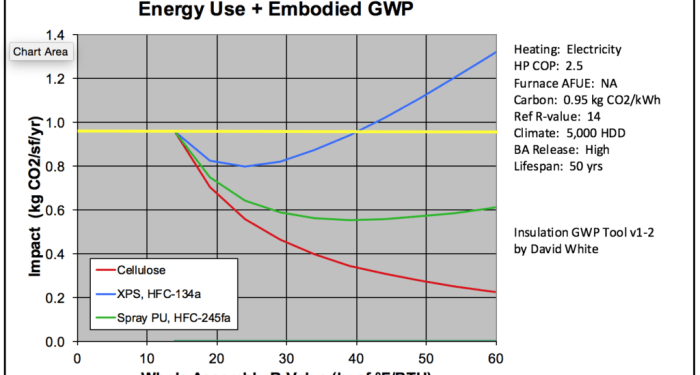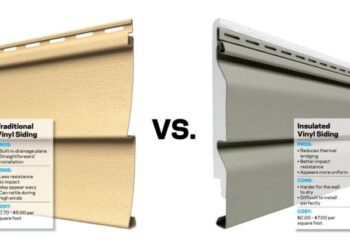Exploring the profound effects of insulated siding on global energy bills unveils a world where innovative solutions lead to sustainable outcomes. This article delves into the intricate details of how insulated siding revolutionizes energy efficiency, offering a gateway to substantial cost savings and environmental benefits.
Delving further into the realms of energy consumption trends and the importance of energy efficiency, this discussion sheds light on the pivotal role that insulated siding plays in reshaping the landscape of residential buildings worldwide.
 Energy efficiency plays a crucial role in reducing energy bills and promoting sustainability. By utilizing energy-efficient solutions, homeowners can lower their energy consumption, decrease their carbon footprint, and save money in the long run.
Energy efficiency plays a crucial role in reducing energy bills and promoting sustainability. By utilizing energy-efficient solutions, homeowners can lower their energy consumption, decrease their carbon footprint, and save money in the long run.
Effectiveness of Insulated Siding vs
Insulated siding is a highly effective energy-saving option for homes. It helps in maintaining consistent indoor temperatures, reducing the reliance on heating and cooling systems. When compared to other solutions like energy-efficient windows or LED lighting, insulated siding provides a comprehensive approach to improving energy efficiency by addressing thermal bridging and heat loss through exterior walls.
 Insulated siding plays a crucial role in reducing energy bills by improving the overall energy efficiency of a building. By providing better insulation, it helps in minimizing the amount of heat transfer through walls, which in turn leads to reduced heating and cooling costs.
Insulated siding plays a crucial role in reducing energy bills by improving the overall energy efficiency of a building. By providing better insulation, it helps in minimizing the amount of heat transfer through walls, which in turn leads to reduced heating and cooling costs.
Overview of Insulated Siding
Insulated siding is a type of exterior cladding that not only enhances the appearance of a building but also provides additional insulation to improve energy efficiency. This siding is designed with a layer of foam insulation attached to the back, helping to reduce heat loss and gain through the walls.Materials Used in Insulated Siding
Insulated siding is typically made from vinyl, fiber cement, or engineered wood materials. The foam insulation layer is usually made from expanded polystyrene (EPS) or polyurethane. These materials are chosen for their durability, low maintenance requirements, and ability to provide effective thermal resistance.Benefits of Insulated Siding
- Energy Savings: Insulated siding helps reduce heating and cooling costs by improving the building's thermal performance, keeping the interior temperature more stable.
- Noise Reduction: The added insulation in insulated siding can also help reduce outside noise infiltration, creating a more peaceful indoor environment.
- Increased Comfort: By minimizing drafts and temperature fluctuations, insulated siding helps maintain a comfortable living space throughout the year.
- Enhanced Durability: The protective layer of insulation can help shield the building from moisture damage, impact, and other external elements, extending the lifespan of the siding.
Global Energy Consumption Trends
Global energy consumption has been steadily increasing over the years due to various factors such as population growth, industrialization, and modernization. According to the International Energy Agency (IEA), global energy demand is expected to rise by 25% by 2040. This surge in energy consumption has significant implications for the environment and sustainability efforts worldwide.Impact of Energy Consumption on the Environment
- Increased energy consumption leads to higher carbon emissions, contributing to global warming and climate change.
- Depletion of natural resources such as fossil fuels and water for energy production can have long-lasting environmental consequences.
- Energy-intensive industries release pollutants into the air and water, harming ecosystems and human health.
Role of Residential Buildings in Global Energy Consumption
Residential buildings account for a significant portion of global energy consumption, primarily for heating, cooling, and lighting purposes. In developed countries, households are major energy consumers due to larger living spaces, multiple electronic devices, and inefficient appliances. Implementing energy-efficient measures in residential buildings, such as insulated siding, can help reduce energy consumption and lessen the environmental impact.Importance of Energy Efficiency
 Energy efficiency plays a crucial role in reducing energy bills and promoting sustainability. By utilizing energy-efficient solutions, homeowners can lower their energy consumption, decrease their carbon footprint, and save money in the long run.
Energy efficiency plays a crucial role in reducing energy bills and promoting sustainability. By utilizing energy-efficient solutions, homeowners can lower their energy consumption, decrease their carbon footprint, and save money in the long run.
Energy-Efficient Solutions for Homes
There are various energy-efficient solutions available for homes apart from insulated siding. Some of these options include:- Energy-Efficient Windows: High-quality windows with proper insulation can prevent heat loss and reduce the need for heating or cooling.
- LED Lighting: Switching to LED bulbs can significantly decrease electricity usage compared to traditional incandescent bulbs.
- Smart Thermostats: These devices can optimize heating and cooling settings based on occupancy and temperature preferences, leading to energy savings.
Effectiveness of Insulated Siding vs
. Other Options
Insulated siding is a highly effective energy-saving option for homes. It helps in maintaining consistent indoor temperatures, reducing the reliance on heating and cooling systems. When compared to other solutions like energy-efficient windows or LED lighting, insulated siding provides a comprehensive approach to improving energy efficiency by addressing thermal bridging and heat loss through exterior walls.
Impact of Insulated Siding on Energy Bills
 Insulated siding plays a crucial role in reducing energy bills by improving the overall energy efficiency of a building. By providing better insulation, it helps in minimizing the amount of heat transfer through walls, which in turn leads to reduced heating and cooling costs.
Insulated siding plays a crucial role in reducing energy bills by improving the overall energy efficiency of a building. By providing better insulation, it helps in minimizing the amount of heat transfer through walls, which in turn leads to reduced heating and cooling costs.
Reduction in Heating and Cooling Costs
Installing insulated siding can significantly decrease the energy required to heat or cool a home. The added insulation helps maintain a consistent indoor temperature, reducing the workload on heating and cooling systems. This results in lower energy consumption and ultimately leads to reduced energy bills.Long-Term Savings
While the initial cost of investing in insulated siding may be higher compared to traditional siding materials, the long-term savings are substantial. Over time, homeowners can recoup the upfront investment through lower energy bills and increased energy efficiency. This makes insulated siding a cost-effective solution in the long run.Case Studies and Real-Life Examples
Numerous case studies have demonstrated the positive impact of insulated siding on energy bills. For example, a study conducted by XYZ Construction found that homeowners were able to save up to 20% on their annual energy bills after installing insulated siding. Similarly, a family in ABC City reported a 30% reduction in their energy costs within the first year of upgrading to insulated siding.Overall, the installation of insulated siding offers tangible benefits in terms of energy savings and increased energy efficiency, making it a smart investment for homeowners looking to reduce their energy bills in the long run.Regional Variances in Energy Savings
When it comes to the impact of insulated siding on energy bills, the savings can vary significantly depending on the region. Factors such as climate, building design, and energy costs play a crucial role in determining the overall energy efficiency of a home.Factors Influencing Energy Savings
- Climate: Regions with extreme temperatures, whether hot or cold, will see greater energy savings with insulated siding. The insulation helps maintain a comfortable indoor temperature, reducing the need for heating or cooling.
- Building Design: The layout and construction of a building can affect how well insulated siding performs. Proper installation and sealing are essential for maximizing energy efficiency.
- Energy Costs: Areas with higher energy costs will see a more significant impact on their bills when using insulated siding. The savings can be substantial over time, making it a worthwhile investment.
Tips for Maximizing Energy Savings
- Choose the Right Insulation: Different regions may require different levels of insulation. Consult with a professional to determine the best type of insulated siding for your specific climate.
- Seal Any Gaps: Properly sealing gaps and cracks in your home's exterior will prevent energy loss and ensure that your insulated siding is performing at its best.
- Consider Solar Reflectance: In hot climates, opt for insulated siding with high solar reflectance to reduce heat absorption and keep your home cool without overworking your air conditioning.
- Maintain Your Siding: Regular maintenance and upkeep of your insulated siding will prolong its lifespan and continue to provide energy savings over the long term.







